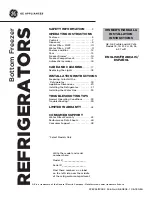
10
GENERAL MAINTENANCE INSTRUCTIONS
CASTERS
Some casters are equipped with Zerk grease fittings so that they may be
easily lubricated with a grease gun. It is recommended that all caster bear-
ings need to be lubricated with a high quality multi-purpose grease that has
good extreme pressure and anti-wear characteristics, as well as withstands
temperature range that fits the application requirements. Wheel and swivel
bearings last longer if lubricated regularly.
It is recommended to lubricate the bearings at least once every six months.
Lubrication will be required more frequently if carts are cleaned with a hot
water or steam cleaning system.
HINGES
Your cart doors and hinges have been factory aligned to assure positive latching and smooth action. If doors
are removed for cleaning, we recommend that they be put back on the same cart to assure the best possible
alignment and operation. Correct hinge alignment is based on the correct gasket compression of 1/32” to 1/16”.
The hinges also need to be aligned with the door strike to accommodate the locking cylinder. To adjust hinge
alignment, it is recommended to use assistance. It is recommended to loosen the bolts on the cabinet side of
the hinge and apply pressure inward on the door to form the seal on the gasket. Align the door as needed and
while maintaining pressure, tighten the bolts.
LATCHES
Check frequently to insure that all door latches are secure. Latches may become “sticky” due to residue build-
up from daily use and cleaning. Lubricate latches regularly with WD-40, silicone spray, graphite or other com-
mercial lubricants for stainless steel products. Do not use oil. If latches require adjustment, it is recommended
to use assistance. First, loosen the screws on the latch. Next, align the latch to compress the seal of the gasket
by applying pressure to the door while the screws are still loose. Lastly, while maintaining pressure to the door,
tighten the screws on the latch.
PERIMETER BUMPERS
Vinyl which has been dislodged from the channel due to severe bumping or scraping can corrected by carefully
utilizing a screwdriver to guide the rubber bumper back into the bumper channel.
DRAINING CONDENSATE PAN
Depending on environmental and operating conditions, manually draining the condensate pan may be neces-
sary. It is recommended that the condensate levels in the pan be checked regularly to gauge the necessary
frequency, if needed, of manually draining the pan. It is also recommended that the condensate level be
checked prior to transport of the unit to prevent possible spillage.
To manually drain the condensate pan, open the valve located on the underside and towards the rear of the
unit. Rotate the valve lever counter-clockwise until it stops (parallel with tubing). Once condensate pan has
been emptied, turn valve lever clockwise until it stops (perpendicular to tubing).
CLOSED
OPEN






























